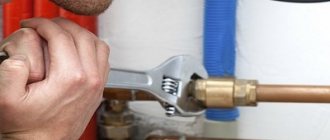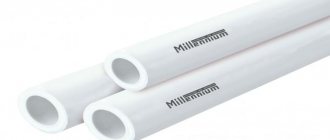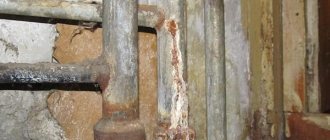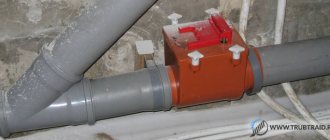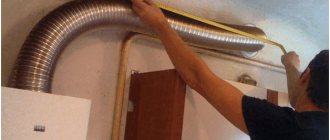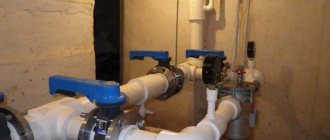Reliable communications are the key to your peace of mind
Unfortunately, residents of old apartment buildings often have to replace hot and cold water supply risers due to their wear and tear. What problems arise in this case, and is it possible to do this work yourself? We will try to give answers to burning questions related to this topic in our publication.
What are water supply risers in an apartment building?
The vertical water supply system that delivers water from the main water supply of the house to the apartments (apartment inlet) is called water supply risers.
The risers are mounted in pairs and parallel. By paired gasket we mean the installation of hot and cold water supply (DHW and cold water supply). Parallel installation means that hot water and cold water are laid along parallel routes, usually in the bathroom. The distance between the DHW and cold water risers is from 250 mm.
For example, in the photo we see risers made of galvanized steel pipe with a welded connection.
risers made of galvanized steel pipe
Repair of pipes throughout the entire entrance
The most correct and least expensive way is to replace the riser in all apartments connected to it.
This will provide the following benefits:
avoid repeated work in the apartment, with damage to the finishing, when replacing risers from neighbors;- achieve a larger discount, since the contractor will be more interested in receiving a large volume of work;
- obtain a higher-quality pipe connection, without additional elements of transition from plastic pipes to steel ones;
- it is easier to resolve all organizational issues regarding disconnecting the riser;
- involve the management company as an organizer and supervisor of the work if the work will be carried out by a third-party organization;
- responsibility, in case of damage, will no longer lie with one owner, it can be assigned to the management company;
- you will not have to pay for disconnecting and connecting the riser.
Material for water pipes
Since water supply risers belong to the water supply system of an apartment building, any available water pipes are suitable for riser pipes. Namely,
- metal-polymer pipes (SP 40-103-98);
- galvanized steel water and gas pipes (GOST 3262-62),
- seamless steel cold/heat-drawn, cold/warm-rolled pipes (GOST 8733-66) with protective coatings against corrosion;
Read: What is a water distribution comb
And also, according to SNIP 2.04.01-85:
- plastic pipes made of polyethylene, polypropylene, polyvinyl chloride, polybutylene;
- fiberglass pipe
- pipes made of other plastics.
In addition, pipes (according to SNIP 2.04.01-85) from:
- Copper, bronze and brass.
As you can see, according to the standards, water supply risers in an apartment building can be installed from any water pipes.
The same statement applies to replacing riser pipes (risers) in a single apartment.
Who is responsible for what
Repair and replacement of water supply risers must be carried out by a service organization.
The riser belongs to the area of responsibility of the organization that services the house. All activities carried out with it - repairs, replacement, etc. - are carried out at the expense of the rent paid monthly by apartment owners. Sunbeds are the property of the apartment owners, so all repair and replacement costs fall on their shoulders. This also applies to the locking device.
If the water supply riser requires repair, and the management organization is delaying it, the residents of the house can carry it out themselves. This event must be agreed upon with the management organization. The contract specifies the timing of the work, because during this period the water supply to several apartments located above each other will be turned off.
To replace the riser, it is necessary to agree on the type of pipe so that unforeseen situations do not occur in the future. The pipe material is usually indicated in the building passport.
Features of installation of risers
In practice, and most likely according to regulations, there are the following rules for installing water pipe risers:
- The hot water pipe is located to the right of the hot water riser;
- When laying parallel along the horizon, the cold water pipe is mounted under the hot water pipe to avoid the formation of water drops due to condensation;
- On all risers made of metal pipes, in front of the shut-off valves, both at the mains and at the collapsible water supply of the apartment, drains must be installed;
- HVS risers are attached to the walls with hooks. DHW risers are attached to the walls with clamps;
- In an apartment building, risers are mounted on half the floor.
Read: Three methods to measure water pressure in an apartment
When should you change?
Common reasons, other than major repairs, are:
- water leaks through fistulas as a result of severe corrosion of the pipe;
- the welding seam of the pipe has broken;
- there is no pressure, the pipes are clogged with deposits and rust;
- The apartment is being renovated and the pipes are being changed at the same time, so as not to return to this issue later.
Which pipes to choose to replace a cold water riser
On the modern market you can find such pipe options as:
- polypropylene;
- copper;
- metal-plastic;
- steel.
It is better to refuse copper and steel products immediately. Despite its reliability and long service life, copper is absolutely not suitable for plumbing. This is because it negatively affects the quality of water, which may subsequently become undrinkable. And steel pipes are significantly inferior to modern polymer options in terms of operational parameters, cost, and ease of installation. In fact, it is almost impossible to install steel pipes efficiently on your own.
Based on this, the choice usually occurs between polypropylene and metal-plastic products. Any of these options are perfect for self-installation.
Metal-plastic structures are highly reliable. To fasten them together, special fittings are used, thanks to which there is no need to use any additional tools. And the sufficient flexibility of the pipes will make their installation even easier. The disadvantage of this material may be its high cost. In this case, the connection areas will have to be checked periodically, since they are the most vulnerable point in structures of this type.
Remember that it is recommended to make the cold water pipeline from the same type of pipes, because this will reduce the risk of damage or leakage.
The price of polypropylene products is much more favorable. However, in order to connect them, you will need to master additional skills, namely the use of a special soldering machine. Thanks to this method, the connections are quite strong and reliable. And in order to correct a defect that occurred during installation, it is enough to throw away the damaged section and attach another one. Polypropylene pipes can be regular or foil-lined (intended for installing a hot water pipeline).
Recommended articles on this topic:
- Arrangement of a small apartment
- Stages of renovation in an apartment
- Turnkey cosmetic repairs
Plastic pipes for water supply
A modern alternative to metal products is plastic pipes, which have many advantages and disadvantages compared to their more traditional steel counterparts. In particular, polymer products are lightweight, simplifying transportation and installation, and have good performance characteristics and low cost.
There are two main types of plastic pipes used in plumbing:
- Polyethylene;
- Polypropylene.
It is worth considering both types in more detail.
Steel risers
Today, most heating system pipelines in our country are made of steel pipes. Therefore, a new ordinary iron riser will “fit” well into the old pipeline. When installed correctly, it can withstand 6-8 atmospheres of pressure. The temperature, which in heating pipes and radiators does not exceed 110 0C, is not dangerous for an iron riser. Service life is about 50 years.
Disadvantages include the possibility of corrosion and the need to periodically repaint the surface.
How does it change on its own?
This is the least desirable option. All responsibility in case of flooding of neighbors will be borne by the owner of the apartment. And perhaps the person who performed the work, if the owner proves that he did not know about the work, or was misled about the qualifications of the contractor.
Attention! If you do not agree on the replacement of the riser, much less notify the management company about this, then administrative liability for interfering with the operation of utility networks is possible.
But there is no direct legislative ban on carrying out work . You have to start the same way, with an application to the Criminal Code. In which it is requested to turn off the riser and it is mandatory, for safety reasons, to carry out pressure testing of the riser by the employees of the management company upon completion of the work.
In this case, there is a chance to share responsibility with the management company. In addition, it is worth pointing out the need to remove the seal from the meter and reseal it. It may be possible without unsealing, but it’s better to warn the Criminal Code.
If you can come to an agreement with the neighbors below and above, then it is better to connect to the old pipe from them.
What pipe diameter to choose for water supply in a private house
As shown above, the pipe diameter is specified by fixed values from a standardized number series with a significant variation. This makes accurate calculation using formulas, tables and online calculators a meaningless procedure in the vast majority of cases. Even the simplest option of determining the diameter based on the throughput of pipes and summing up the water consumption of simultaneously turned on plumbing equipment (Table 3.) is not worth the time spent and was carried out long ago by specialist installers.
Outside
If an individual water supply system is installed for a private house, then water from a submersible or surface electric pump enters it through an underground pipeline made of low-density polyethylene HDPE.
The outlet pipes of most pumps are designed to accept pipes with a diameter of 1 or 1 1/4 inches, that is, outer diameters of 25 and 32 mm. Since the pipeline from electric pumps is prohibited from being narrowed, installers have no choice which pipes to use.
Sometimes, if the outlet of the electric pump has a 1-inch (25 mm) outlet pipe, and the distance to the house is too great, a larger diameter 1 1/4-inch (32 mm) pipeline is used to reduce hydraulic losses.
The same applies when connecting from a centralized water main. In the vast majority of cases, installers do not face the question of which pipe to choose. It is enough to use two types - 25th or 32nd HDPE pipes.
Rice. 5 One of the options for manifold wiring and corresponding pipes made of thin-walled metal-plastic (for PP, all diameters should be increased by one standard size)
Instructions for replacing water supply risers
- First of all, you should turn off the water, and then cut off all unnecessary and old fragments.
- Now you need to prepare the edges of the pipelines for threading. Using a grinder, old paint, primer, and other spraying are removed from pipelines. After which, for more successful thread cutting, the chamfer is removed.
- Using a tool of the required diameter, as well as a tool holder, threads are cut.
- Then you need to wind the winding onto the finished thread. It should be wound strictly clockwise, so that during the process of winding the part it does not screw onto the thread more tightly, or, on the contrary, slips off it.
- Also, special transitions from metal to plastic must be screwed onto the winding threads.
- A tee is soldered into the pipeline to supply water to the room, after which a tap is installed. When using a plastic-based tap, it also needs to be soldered. So, the water supply riser is completely ready, all that remains is to wire the piping throughout the apartment.
What determines the choice of diameter?
The choice of diameter of the PP pipeline depends on:
- purposes of application;
- pressure forces;
- workload;
- number of water sources.
As a rule, the inlet pipe has a diameter of 32 mm. For wiring, PPT 16-20 mm is used. Moreover, the internal diameter of the pipes directly depends on the thickness of their walls, so this parameter is one of the most important when installing a water supply system. For the most accurate representation, there is a special correspondence table.
Diameter of polypropylene pipes table:
For plumbing systems, pipes with an outer diameter of 21 to 25 millimeters are most often used, which is similar to standard steel pipes with a diameter of ½ and ¾ inches. For risers, products with a diameter of 32 to 40 millimeters are used.
There are several types of diameters among polypropylene pipes:
- 16-1200 mm;
- 16-32 mm in the case of household products;
- 40-50 mm for internal sewerage.
The maximum possible pipe diameter is 110 mm. However, it is applied only in the case of arrangement of sewers in large apartment buildings.
The maximum pressure at which a particular polymer pipe can be used is indicated in the marking. For example, the inscription PN10 means that the product should be operated at a pressure of no more than 10 bar, PN20 - no more than 20 bar. In addition, the markings indicate the temperature in degrees.
Polypropylene tubes have a high expansion coefficient: when the temperature changes during the use of the line, the dimensions of the PPT change noticeably.
The internal diameter depends on the permeability of the water supply. The following factors influence the level of cross-country ability:
- internal cross-section (the smaller it is, the weaker the flow);
- total pressure inside the system;
- deposits inside the pipes (depending on the service life of the product);
- number of transitions, turns and joints;
- composition of raw materials PPT (with a smoother surface, pressure and permeability will increase);
- total length of the pipeline (with a large length, the permeability decreases).
The diameter and wall thickness directly depend on the purpose of use and the class of the pipe. To find out the exact diameter, there is a special calculation based on the measurement of hydraulic parameters. The main purpose of this calculation is to obtain the most accurate diameters.
During the calculation, all aspects must be taken into account, including the system structure and operating pressure. For example, pipes for a heating system differ significantly from products for cold water supply. In most cases, for trouble-free operation of the main line without failures, it is necessary to use pipes with a large cross-section, which will increase costs several times. If you ignore the need for a large cross-section, the pressure will noticeably decrease.
Stainless steel and copper pipes
These two materials are very strong and durable. They withstand high pressure and very high temperatures. However, is it advisable to use them for heating risers? Copper pipes are quite expensive. If the rest of the network is not made of copper (which is most likely), then the connection of different metals into one system leads to rapid destruction due to corrosion of the more active of them. For this reason, you should not connect copper pipelines with pipelines made of aluminum, steel, or galvanized metal. To prevent the corrosion process from occurring, it is necessary to install passive anodes, for example, made of magnesium, in such pipes. Another problem with copper pipes is stray currents. For protection, reliable grounding must be provided.
Stainless steel “behaves” when connected into one pipeline with other metals in the same way as copper. In addition, in addition to the high cost of the material itself, installation of stainless steel pipes is very expensive.
When is it necessary to replace a cold water riser?
It is necessary to replace the vertical cold pipeline due to the expiration of the service life of the metal structure or to completely repair the bathroom.
There are 2 riser replacement modes, which are chosen taking into account the current conditions:
- planned - if the water pipes are worn out;
- emergency - when a malfunction occurs and a leak appears.
Those residential cold water supply pipelines, which were installed from the very beginning in old buildings, are made of cast iron or galvanized pipes. And since the metal is susceptible to corrosion, after some time the products made from it require replacement.
The heaviest wear occurs in the floors between floors. Therefore, you should connect the old and new pipes outside these ceilings (in the bathrooms of neighboring apartments located on the floor above or below).
The service life of pipes made of metal is approximately 25 years. In fact, they can last much longer. However, after forty years of operation, their condition will already be in disrepair.
Do not look at the fact that after the end of their service life the structures seem intact. In any case, they should be replaced. An old pipe that has served its purpose is a high risk. Sooner or later it will burst. And the consequence will be significant losses for both parties - the guilty and the victim.
It is better to carry out a planned replacement of the cold water riser during a major overhaul. In modern interior design options, the cold pipeline is often hidden in the wall, which makes it quite difficult to work with it later if necessary.
Materials and tools
The easiest way is to replace any pipes with polypropylene ones, especially since you can even purchase pipes with a pressure of 25 bar for high-rise buildings. Most often this is what they do.
Tools for dismantling will be needed:
- angle grinder (grinder) with a cutting wheel for metal;
- small sledgehammer 3-5 kg;
- locksmith's key number 2-3;
- hammer drill or electric hammer.
For installation you need to prepare the following tools and materials:
- soldering kit for plastic pipes with scissors;
- tee for connecting an apartment;
- faucet for soldering to plastic, with the transition to residential wiring, taking into account the material of the internal water supply pipes;
- 2 transition elements for connecting a plastic pipe to a steel pipe (more about them below);
- 4 meters of pipe (2x2), taking into account the thickness of the ceiling and the approach to neighbors of 20 cm;
- wall mounting clamps;
- die for cutting threads on an old steel pipe
- 2 bends complete with couplings and locknuts if the threaded option is selected.
We recommend an article on the topic
Details about cold water pipes - what material to choose, how to determine the diameter and when is replacement needed?
Before purchasing materials, you need to think about how plastic pipes will be connected to steel ones, as well as how to connect the apartment. These are the most crucial and difficult moments in replacing the riser.
If the metal of the pipe is in good condition, then the best way is to cut a thread, then install the pipe on a coupling with a lock nut and connect it to the pipe with an adapter plastic coupling with an internal thread.
Such a connection can be serviced, and in the event of a leak, disassembled and repacked. Some contractors immediately screw the coupling onto the threads, guaranteeing that there will be no leaks. As a result, you still have to redo it, and relations with neighbors will be ruined.
Advice! You can cut threads on a pipe using grapple. You can do without a special key by turning it with a plumbing (gas) wrench. The Krupp has a guide skirt, so a reliable thread is obtained.
If the metal is severely corroded and there is doubt about the quality of the thread, then GEBO fittings are installed, specially designed for such a connection.
The pipes should be approximately equal in diameter . It is possible to use crimp clamps consisting of two halves with 4 bolts.
In this case, it is also important that both pipes are approximately the same diameter, and a rubber band is applied at the crimping point, which should compress the clamp. This method is the least reliable of all three.
When choosing a tee and a tap, you should think carefully, or better yet, pre-assemble a sequential chain: tee, tap, suitable threaded connection to the outlet to the apartment.
Metal-plastic material
Metal-plastic pipes are lightweight and durable. They will be a good option for installing a water supply system in a multi-storey building. The combination of metal and plastic made this product universal.
Thermal stability indicators depend on the production technology. This can be determined by the color of the product: blue ones are intended for installation of cold water supply pipes, white ones can withstand water temperatures above 45 degrees.
In this case, no problems should arise with the installation procedure. For this purpose, compression fittings of various diameters are used. If fittings are connected with a ferrule, there must be room for regular tightening.
Metal-plastic construction
The presence of a multilayer structure allows us to talk about high strength indicators. Metal-plastic is created in the form of a multi-layer cake and consists of:
- metal frame;
- soft plastic covering the base on both sides.
In this case, the frame can be solid, spiral or perforated.
The service life is about 35 years. The material can withstand heating up to 75 degrees.
The advantages of this material include:
- Ease of assembly of structures and its further operation;
- When heated, they are able to bend and take the desired shape;
- Relatively low price;
- Soldering takes place directly and does not require additional equipment for connection;
- Resistant to low temperatures, so they can even be laid in the soil.
Quietness can also be considered a positive feature. Thanks to the features of the multilayer design, they absorb noise well.
This type also has its disadvantages. Metal-plastic does not tolerate sudden temperature changes, which can cause delamination of the base. It is worth mentioning the fitting connection, which is not reliable.
Material selection
Even the replacement of a pipeline is construction; therefore, it is recommended to treat all plumbing work with particular seriousness, this also applies to the purchase of material.
For main pipelines, it is advisable to use metal-plastic pipes, but a more budget-friendly option, polypropylene pipes, can also be used.
metal-plastic pipes are the best option for the bathroom
They are adapted to various conditions; in addition, they are able to withstand water pressure of up to 10 atmospheres and temperatures of up to 95°C.
There are the following types of metal-plastic pipelines:
- Seam pipes - used for open installation; there is a seam on the inner surface of the pipeline.
- Seamless pipes - used for closed installation, unlike open installation, they are characterized by a more neat appearance. This option cannot be repaired; if it fails, only complete replacement of the pipelines is possible.
